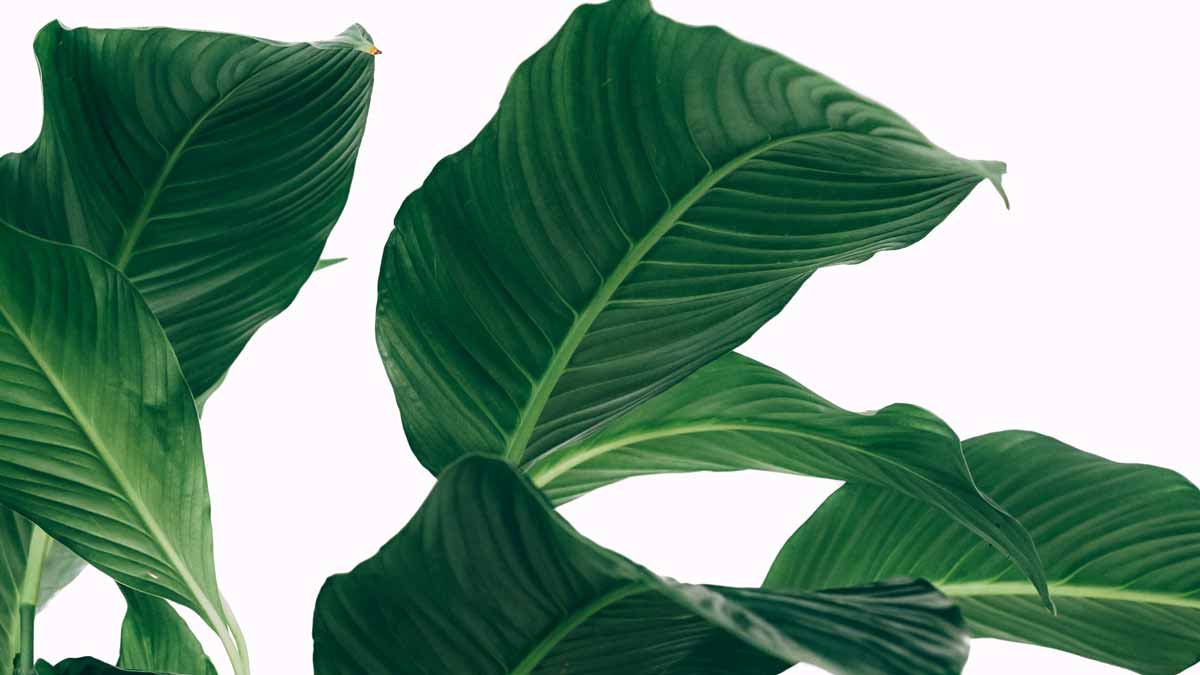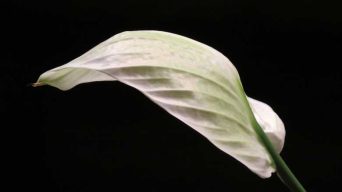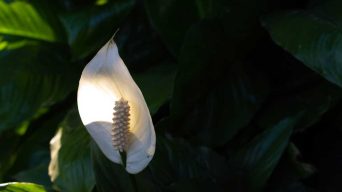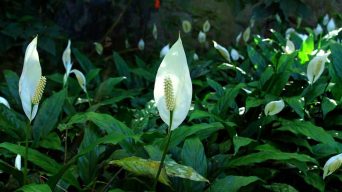Peace Lily plants are beautiful, low-maintenance houseplants that can brighten up any room.
They are also very resilient and can tolerate various growing conditions.
However, even the toughest Peace Lily can experience problems from time to time.
One of the most common problems is curling leaves.
Although several factors can cause Peace Lily curling leaves, some simple solutions can help fix the problem.
Why Are My Peace Lily Leaves Curling and How Can You Fix It?
There are several reasons why your Peace Lily leaves may be curling.
The most common causes are listed below, along with some simple solutions to help fix the problem.
1. Underwatering
Leaves typically curl when the Peace Lily plant is not getting enough water.
Underwatering can cause Peace Lily leaves to curl in several ways.
First, it can cause the leaves to become dry and brittle.
As the water evaporates, Peace Lily leaves will begin to droop and curl.
Second, an underwatered Peace Lily can become stressed.
When a Peace Lily is stressed, its leaves often curl as a defense mechanism.
Finally, underwatering can also cause Peace Lily leaves to turn brown or yellow.
This is because the plant cannot photosynthesize properly without adequate moisture.
As a result, Peace Lily leaves will often curl when the plant is not getting enough water.
How To Fix It
If your Peace Lily leaves are curling, the first thing you should do is check the soil.
If the soil is dry, water your plant immediately.
Be sure to water deeply until water drains from the pot’s bottom.
You may also need to increase the frequency with which you water your plant.
Peace Lilies typically need to be watered once a week, but they may need to be watered more often if the plant is in a warm or dry environment.
Once you have increased the watering frequency, you should see the leaves begin to uncurl within a few days.
2. Overwatering
Although underwatering is the most common cause of curling leaves, overwatering can also be problematic.
Excessive watering of a Peace Lily can lead to various issues.
The first is that it can cause the leaves to turn yellow, brown, and drop off.
This is because the roots cannot get enough oxygen when sitting in water.
The second problem that overwatering can cause is root rot.
The roots start to break down and decay because they sit in water.
Root rot can kill your Peace Lily.
The third problem that overwatering can cause is leaf spot.
This is when yellow or brown spots appear on houseplant leaves.
Leaf spot is usually caused by a fungal disease that thrives in wet conditions.
How To Fix It
If you think your Peace Lily is overwatered, check the soil first.
If the soil is wet or soggy, stop watering your plant immediately.
Next, remove your plant from its pot and check the roots.
If the roots are brown or mushy, they are probably rotting.
In this case, you must repot your plant in fresh, dry soil.
If the roots are healthy, allow the plant to dry out for a few days before watering it again.
3. Too Much Sun
If you notice your Peace Lily’s leaves curling and turning yellow, it may get too much sun.
While Peace Lilies can tolerate some direct sunlight, they do best in bright indirect light.
A Peace Lily needs about 4-6 hours of bright indirect light daily.
However, if Peace Lily leaves are exposed to direct sun for extended periods, they will start to sunburn.
This usually manifests itself in the form of yellow leaves that eventually curl up and die.
How To Fix It
If your Peace Lily is getting too much sun, the best solution is to move it to a location with less direct sunlight.
You should also ensure that you are not exposing your plant to direct sunlight for more than 4-6 hours daily.
When grown indoors, a Peace Lily should be placed near an east- or west-facing window.
This will give the plant the bright indirect light it needs without exposing it to too much direct sunlight.
4. Heat Stress
If you live in a particularly hot or humid climate, your Peace Lily may be experiencing heat stress.
This can cause the curled leaves to have brown tips.
When the Peace Lily is exposed to high temperatures, the leaves will curl to conserve water and prevent further evaporation.
While this curling behavior benefits the plant in the short term, it can ultimately lead to Peace Lily’s leaves drying out and damaged.
How To Fix It
To fix this problem, you’ll need to provide your Peace Lily with some relief from the heat.
The best way to do this is by moving the plant to a cooler location that receives indirect sunlight.
Remember that Peace Lilies are tropical plants, so they prefer warm temperatures.
As such, you’ll want to avoid placing them in locations that are too cold, as this can also cause damage to the leaves.
You can also try using a humidifier to increase the humidity around the plant.
This will help to prevent the leaves from drying out.
If you live in a particularly hot climate, you may also want to mist the plant’s leaves regularly.
Just be sure not to overdo it, as too much water can lead to root rot.
5. Cold Temperatures
Peace Lily leaves may curl due to cold temperatures.
Peace Lilies are tropical plants that prefer warm, humid conditions.
When exposed to cold temperatures, the Peace Lily’s leaves will begin to curl to conserve heat and protect the plant from further damage.
The Peace Lily is not the only plant that reacts to cold temperatures in this way.
Many other tropical plants will also curl their leaves when exposed to cold temperatures.
By curling their leaves, these plants can reduce heat loss and prevent further damage from the cold.
How To Fix It
If your Peace Lily’s leaves are curling due to cold temperatures, the best thing you can do is move the plant to a warmer location.
If possible, try to find a spot out of the direct path of drafts or air conditioning vents.
You may also consider using a humidity tray or humidifier to raise the humidity around the plant.
Increasing the humidity will create a more hospitable environment for your Peace Lily and help prevent its leaves from curling.
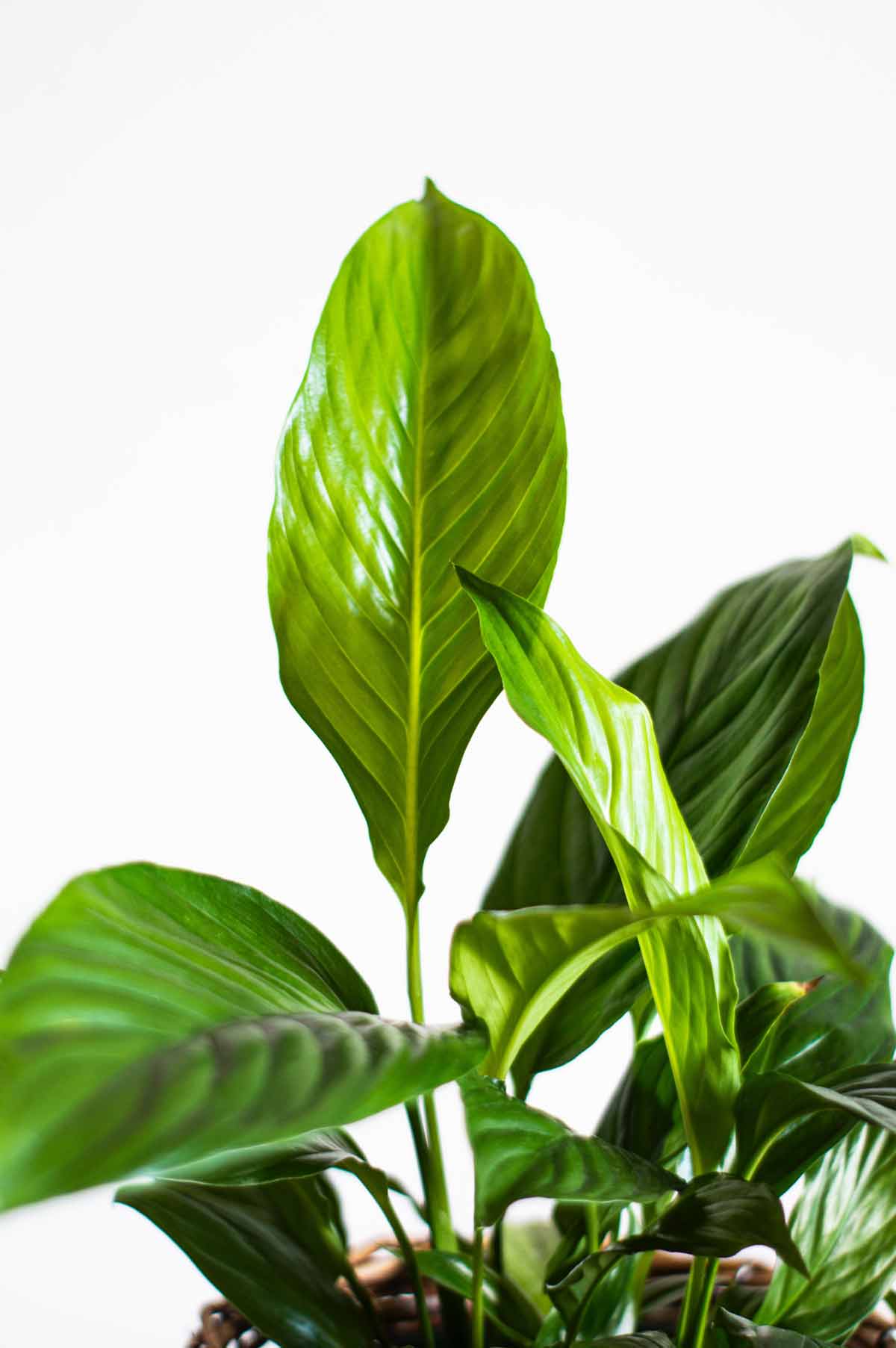
6. Nutrient Deficiency
Nutrient deficiency is one of the most common reasons for Peace Lily leaves curling.
If your plant isn’t getting enough of a certain nutrient, it will start to show signs of distress.
The most common nutrient deficiency in Peace Lilies Is nitrogen.
If your Peace Lily has yellow leaves with green veins, it is likely nitrogen-deficient.
This can be caused by too much water, which washes away nutrients from the soil.
It can also be caused by using the wrong type of potting soil or not fertilizing it properly.
How To Fix It
If you think your Peace Lily is suffering from a nutrient deficiency, you should first fertilize it.
You can either use a liquid fertilizer or slow-release pellets.
If you’re using liquid fertilizer, dilute it properly and only fertilize your plant every two weeks or so during the growing season.
If you’re using slow-release pellets, you can add them to your potting mix at the beginning of the season.
Another way to help your Peace Lily get the nutrients it needs is to repot it in fresh potting soil.
Over time, the soil in your pot will become depleted of nutrients.
So, repotting your plant every few years will help it stay healthy and vigorous.
7. Pests
If you see your Peace Lily leaves curling and notice small insects on the plant, your plant likely has pests.
The most common Peace Lily pests are aphids, thrips, and mealybugs.
Aphids are small, pear-shaped insects that are usually green but can also be black, brown, or white.
They congregate on the undersides of leaves and suck the sap from the plant, which can cause the leaves to curl.
Thrips are tiny, winged insects that are usually black or brown.
They feed on the sap of the plant, which can cause leaves to curl and discolor.
Mealybugs are small, white insects that congregate on the stems and undersides of leaves.
They suck the sap from the plant, which can cause the leaves to curl and turn yellow.
How to Fix It
If you think your Peace Lily has pests, the first step is to isolate the plant from other plants.
Then, inspect the plant carefully and remove any insects you see by hand.
You can also use a cotton swab dipped in rubbing alcohol to remove the insects.
You can also use insecticidal soap or neem oil to eliminate the pests.
These are natural solutions that won’t harm your plant.
Once you’ve removed the pests, you should see a noticeable difference in your plant’s health.
The leaves should stop curling, and the plant should start to grow again.
8. Compacted Soil
Peace Lily leaves typically curl when the soil they are planted in is compacted.
This is often caused by too much water, which will compress the soil and make it harder for the plant to breathe.
Too dense soil can prevent Peace Lily roots from taking in the moisture and nutrients they need to thrive.
As a result, Peace Lilies may suffer from dehydration and nutrient deficiency, causing their leaves to curl.
In some cases, compacted soil may also cause Peace Lily leaves to turn yellow or brown.
How To Fix It
The best way to fix compacted soil is to remove the plant from its pot and loosen the soil around the roots.
You can also add fresh, well-aerated soil to the pot to help improve drainage.
You can also add perlite or vermiculite to the potting mix to help improve drainage.
If your Peace Lily is growing in a garden bed, you may need to aerate the soil with a pitchfork or other tool.
Make sure to water your plant regularly and deeply to encourage healthy growth.
9. Transplant Shock
Transplant shock is another common reason for Peace Lily leaves to curl.
Transplant shock occurs when a plant is moved from one location to another, which can cause the roots to become damaged.
This damage can prevent the plant from taking in the moisture and nutrients it needs to thrive, causing the leaves to curl.
Transplant shock can also cause Peace Lily leaves to turn yellow or brown.
How To Fix It
The best way to fix transplant shock is to give your plant time to adjust to its new location.
Make sure to place the plant in an area where it will receive the same light and water as before.
Avoid moving your plant too often, as this can cause further stress.
Give your plant time to adjust; the leaves should uncurl within a few weeks.
10. Low Humidity
Peace Lily leaves typically curl when the humidity is too low.
Peace Lilies are native to tropical regions with high humidity, so they require more humid conditions to thrive.
When the air is too dry, the Peace Lily leaves will begin to curl to prevent moisture loss.
If the Peace Lily is not exposed to enough humidity, the leaves may also turn brown and eventually die.
How To Fix It
There are several ways to increase the humidity around your Peace Lily.
One way is to place the plant on a pebble tray, which is a tray filled with water and pebbles.
The water will evaporate and help increase the humidity around the plant.
You can also use a humidifier to increase the humidity in the room.
Make sure to keep an eye on the plant and regularly mist the leaves with water.
You can also group your Peace Lily with other plants to create a humidity dome around the plant.
This will help increase the humidity and protect the plant from drying out.
11. Overfertilization
If you think your plant isn’t getting enough nutrients, it’s tempting to pour on the fertilizer.
However, too much of a good thing can harm your Peace Lily.
Overfertilization can cause several problems, including leaf curling.
When you overfertilize, the plant’s roots can’t take up all the nutrients they need.
The excess nutrients then build up in the soil, causing leaf burn and curling.
How To Fix It
If you think you’ve overfertilized your Peace Lily plant, flush the soil with plenty of water to remove the excess nutrients.
You may also need to repot the plant in fresh, well-draining soil.
Avoid fertilizing your Peace Lily for a few months to allow the plant to recover.
How To Prevent Peace Lily Leaves From Curling
Preventing Peace Lily leaves from curling is a matter of providing the right growing conditions for your indoor plant.
Here are a few tips to help you keep your Peace Lily healthy and happy:
- Water your plant regularly and deeply to encourage healthy growth.
- Use a well-draining potting mix to ensure your plant doesn’t become waterlogged.
- Place your plant in a bright, indirect location to prevent the leaves from scorching.
- Be sure to humidity around your Peace Lily by misting
- Ensure the plant is getting bright light, but avoid direct sunlight, which can scorch the leaves.
- Keep the humidity high around your Peace Lily by misting the leaves or placing the plant on a pebble tray.
- Prune any yellow or brown leaves as they appear to keep the plant looking its best.
- Fertilize your Peace Lily every few months to provide the nutrients it needs to grow.
- Check for pests and diseases regularly and treat them as necessary.
With some care, you can keep your Peace Lily looking its best and prevent the leaves from curling.
Final Thoughts
Peace Lily plant care is relatively easy if you provide the right conditions for your plant.
If your Peace Lily leaves are curling, it is most likely due to one of the above reasons.
By taking a closer look at your plant and its surroundings, you should be able to identify the problem and take steps to fix it.
With a bit of care, you can keep your Peace Lily healthy and happy for many years.

